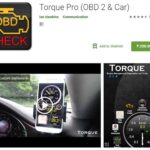Navigating the world of car diagnostics can be confusing, especially when dealing with older vehicles. If you’re searching for “Amazon Obd1 And Obd2 Bluetooth” scanners, you’re likely wondering if you can use a modern Bluetooth OBD2 scanner on an older OBD1 car with a simple adapter. The short answer is: it’s not that straightforward. Let’s clarify the differences between OBD1 and OBD2, and what this means for using Bluetooth scanners.
Understanding OBD1 and OBD2: Two Different Eras of Car Diagnostics
On-Board Diagnostics (OBD) systems are crucial for car maintenance and repair. They monitor various vehicle systems and can alert you to potential problems. However, there’s a significant difference between the older OBD1 and the more modern OBD2 systems.
OBD1 was the first generation of these systems, used in vehicles before the mid-1990s. It wasn’t standardized, meaning each manufacturer had its own connectors, communication protocols, and diagnostic codes. This made it challenging to diagnose issues across different car brands, and even models within the same brand.
OBD2, on the other hand, became mandatory in the USA in 1996. It brought standardization to the diagnostic process. OBD2 systems use a standardized 16-pin Diagnostic Link Connector (DLC), a universal set of diagnostic trouble codes (DTCs), and common communication protocols. This standardization made vehicle diagnostics much more accessible and user-friendly.
The Myth of OBD1 to OBD2 Adapter Cables for Scanners
When searching on Amazon for “obd1 bluetooth scanner”, you might encounter OBD1 to OBD2 adapter cables. These cables can be misleading. While they physically adapt the OBD1 connector to an OBD2 shape, they do not magically convert the diagnostic protocols.
OBD1 and OBD2 systems speak different languages. OBD2 scanners are designed to communicate using the standardized OBD2 protocols. OBD1 systems, lacking this standardization, communicate in various proprietary ways. A simple adapter cable just changes the connector shape; it doesn’t translate the data signals.
Therefore, using an OBD1 to OBD2 adapter cable with a standard OBD2 Bluetooth scanner will not work for reading diagnostic data from an OBD1 vehicle. The scanner simply won’t be able to understand or interpret the signals from the OBD1 system. Think of it like trying to plug a USB drive into an Ethernet port – the shapes might be adaptable, but the underlying technology is incompatible.
Why You See OBD1 to OBD2 Cables on Amazon
If these adapter cables are useless for scanners, why are they sold on platforms like Amazon? The reason is that these cables serve different purposes, mainly related to vehicle modifications and system conversions, not scanner compatibility.
For instance, in some car modification scenarios, mechanics might swap engines or electronic control units (ECUs) between cars with different OBD systems. In these cases, adapter cables might be used to adapt wiring harnesses or power connections, not to make an OBD2 scanner read OBD1 data. These are specialized applications, not intended for basic diagnostic scanning.
True Bluetooth OBD1 Solutions
If you need to perform diagnostics on an OBD1 vehicle and want the convenience of Bluetooth connectivity, you’re not out of luck. The solution is to look for dedicated OBD1 Bluetooth scanners.
These scanners are specifically designed to communicate with OBD1 systems. They often come with:
- OBD1 Compatible Hardware: They have the correct connectors and electronic interfaces to physically connect to OBD1 diagnostic ports.
- OBD1 Software and Protocols: They are programmed with the necessary software and communication protocols to understand and interpret OBD1 data.
- Bluetooth Connectivity: They offer Bluetooth to connect to your smartphone or tablet, often using a dedicated app.
When searching on Amazon or other marketplaces, be specific. Instead of just “OBD1 Bluetooth scanner,” search for terms like:
- “OBD1 ALDL Bluetooth scanner” (for GM vehicles using ALDL protocol)
- “Bluetooth OBD1 diagnostic tool”
- “OBD1 scanner with Bluetooth for [Car Make]” (e.g., “OBD1 scanner with Bluetooth for Chevy”)
You’ll find specialized tools, sometimes from smaller vendors or niche automotive diagnostic companies, that cater to the OBD1 market. These tools will likely be compatible with specific apps, like ALDLdroid mentioned in the original forum, which are designed to work with OBD1 systems.
Conclusion: Choose the Right Tool for the Job
In conclusion, while “amazon obd1 and obd2 bluetooth” searches might lead you to OBD1 to OBD2 adapter cables, remember these are not a solution for using OBD2 scanners on OBD1 cars. These adapters don’t bridge the fundamental communication gap between the two systems.
For diagnosing OBD1 vehicles with Bluetooth, you need to invest in dedicated OBD1 Bluetooth scanners. These tools are designed to speak the language of OBD1 and provide you with the diagnostic information you need. Always ensure that any scanner you consider is explicitly stated to be compatible with OBD1 and ideally, with your specific car make and model for the best diagnostic experience. Using the right tool ensures accurate diagnostics and saves you from the frustration of incompatible adapters.
